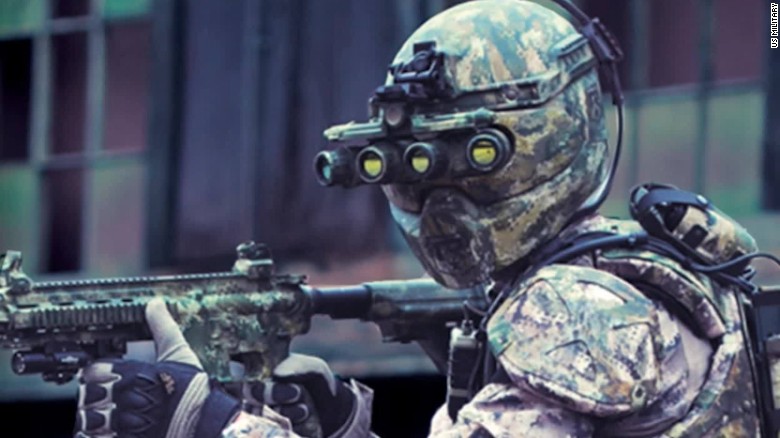TerraN_EmpirE
Tyrant King
In the cold weather I imagine that your fairly well insulated under all that armor. Although there are personal heaters if needed. Infact strehl's link makes a personal heating system for divers.
taken from Army-Reco, Navyreco's ground pounding siblingPublished: Tuesday, 10 November 2015 12:31
Defence & Security News - (B-Temia)
B-Temia and Safran to partner in the field of exoskeletons
The Canadian company B-Temia Inc. and the French Sagem (Safran Group) will partner together in the field of exoskeletons. Today they signed a technology and business development agreement to research, develop and produce a new generation of exoskeletons for military and civilian applications.

A user with a lower limbs exoskeleton. (Photo: B-Temia, courtesy of Revision Military Inc.)
The exoskeletons are skeleton frames made of materials, such as metal alloys. They are worn on the body of the user and movement is carried out through a series of biomechanical and electronic structures. Exoskeletons provide support to the human body, allowing the user to lift a significantly increased weight, thus reducing the damages to the human body.
Under the terms of the agreement, Sagem will contribute its long experience in the integration of complex systems, its innovative actuators and stabilization technologies. B-Temia, will contribute its experience in human robotics and artificial intelligence, based on its proprietary “Dermoskeletontm” technology, already in production for the healthcare sector.
B-Temia’s President and CEO, Stéphane Bédard, said: "B-Temia is very proud of this partnership with Sagem, focused on the development and production of our dermoskeleton products. This agreement confirms our company's technology leadership business value, and the credibility of our work addressing increased human mobility needs in both industrial and defense applications.”
Regarding Sagem’s role, its CEO, Martin Sion added: "Our collaboration with B-Temia will enable us to sustain new R&D work on exoskeletons. For Sagem, this is a very promising technology for industrial and military applications. In particular, our collaboration spotlights the dynamic mindset that Sagem seeks to deploy in the application of innovative dual technologies in conjunction with both startups and major corporations."
Looks like they are starting to really get into it still questions like battery life remain to be answered.
U.S. Military To Deliver Its First Bulletproof, Weaponized Iron Man Suit In 2018
By , Tech Times | October 7, 8:18 AM
National Public Radio (NPR).
Compared to Iron Man's suit, TALOS is a liquid armor that can solidify when it's hit by a bullet, which is more technologically advanced, but it won't have flying capabilities or a built-in JARVIS, although it has in-helmet technologies that improve visibility and provide better communication with the rest of the troop.
A chemical engineering professor from the University of Delaware Norman Wagner applied nanotechnology to produce this adaptive liquid material.
"These particles organize themselves quickly, locally in a way that they can't flow anymore and they become like a solid," Wagner explained the technology to NPR.
Just like Stark's suit, TALOS is fitted with built-in sensors that monitor the wearer's health, checking conditions from heart rate to body temperature.
The suit is far from completion, as the developers are still fine-tuning it to further improve its protection capabilities and cut down its strain on the wearer.
The head U.S. Special Operations Command, Gen. Joseph Votel, took over the project and hopes to have it ready for the U.S. Army as soon as possible to give each soldier "the advantage when he is most vulnerable."
For now, Iron Man-like super suits can only be seen in action on the movie screen.
U.S. military spending millions to make cyborgs a reality
By Ryan Browne, CNN
Updated 12:24 PM ET, Mon March 7, 2016

The Army's real life 'Iron Man' suits 01:10
Washington (CNN)The U.S. military is spending millions on an advanced implant that would allow a human brain to communicate directly with computers.
If it succeeds, cyborgs will be a reality.
The Pentagon's research arm, the Defense Advanced Research Projects Agency (DARPA), hopes the implant will allow humans to directly interface with computers, which could benefit people with aural and visual disabilities, such as veterans injured in combat.
The goal of the proposed implant is to "open the channel between the human brain and modern electronics" according to DARPA's program manager, Phillip Alvelda.
In January, DARPA announced it plans to spend up to $62 million on the project, which is part of its Neural Engineering System Design program.
The implant would be small -- no larger than one cubic centimeter, or roughly the size of two stacked nickels -- according to DARPA.
The implantable device aims to convert neurons in the brain into electronic signals and provide unprecedented "data-transfer bandwidth between the human brain and the digital world," according to a DARPA statement announcing the new project.
DARPA sees the implant as providing a foundation for new therapies that could help people with deficits in sight or hearing by "feeding digital auditory or visual information into the brain."
A spokesman for DARPA told CNN that the program is not intended for military applications.
But some experts see such an implant as having the potential for numerous applications, including military ones, in the field of wearable robotics -- which aims to augment and restore human performance.
Conor Walsh, a professor of mechanical and biomedical engineering at Harvard University, told CNN that the implant would "change the game," adding that "in the future, wearable robotic devices will be controlled by implants."
Walsh sees the potential for wearable robotic devices or exoskeletons in everything from helping a medical patient recover from a stroke to enhancing soldiers' capabilities in combat.
The U.S. military is currently developing a battery-powered exoskeleton, the Tactical Assault Light Operator Suit, to provide superior protection from enemy fire and in-helmet technologies that boost the user's communications ability and vision.
The suits' development is being overseen by U.S. Special Operations Command.
In theory, the proposed neural implant would allow the military member operating the suit to more effectively control the armored exoskeleton while deployed in combat.
However, Steven Pinker, a cognitive scientist and professor of psychology at Harvard, was skeptical of the proposed innovation, calling the idea a "bunch of hype with no results."
He told CNN, "We have little to no idea how exactly the brain codes complex information" and cited the problems from foreign objects triggering brain inflammation that can cause serious neurological issues.
Pinker described "neural enhancement" for healthy brains as being a "boondoggle," but he suggested that there could be some benefit for people suffering from brain-related diseases such as amyotrophic lateral sclerosis (ALS), also known as Lou Gehrig's disease.
In its announcement, DARPA acknowledged that an implant is still a long ways away, with breakthroughs in neuroscience, synthetic biology, low-power electronics, photonics and medical-device manufacturing needed before the device could be used.
DARPA plans to recruit a diverse set of experts in an attempt to accelerate the project's development, according to its statement announcing the project.
Pinker remained skeptical, however, telling CNN: "My guess is that it's a waste of taxpayer dollars."
U.S. Special Operations Command is Engineering a Next-Generation Exoskeleton to Keep Operators Alive

KRIS OSBORN
Monday at 1:03 PM
U.S, Special Operations Command Plans to Have Some Initial TALOS Iron Man suit Prototypes by 2018
U.S. Special Operations Command is making progress researching, developing and testing a next-generation Iron Man-like suit designed to increase strength and protection and help keep valuable operators alive when they kick down doors and engage in combat, officials said.
The project, formally called Tactical Light Operator Suit, or TALOS, is aimed at providing special operators, such as Navy SEALs and Special Forces, with enhanced mobility and protection technologies, a Special Operations Command, or SOCOM, statement said.
"The ultimate purpose of the TALOS project is to produce a prototype in 2018. That prototype will then be evaluated for operational impact,” Lt. Cmdr. Matt Allen, SOCOM spokesman, told Scout Warrior.

Industry teams have been making steady progress on the technologies since the effort was expanded in 2013 by Adm. William McCraven, former head of SOCOM.
“I’m very committed to this because I would like that last operator we lost to be the last operator we ever lose,” McCraven said in 2013.
Defense industry, academic and entrepreneurial participants are currently progressing with the multi-faceted effort.
The technologies currently being developed include body suit-type exoskeletons, strength and power-increasing systems and additional protection. A SOCOM statement said some of the potential technologies planned for TALOS research and development include advanced armor, command and control computers, power generators, and enhanced mobility exoskeletons.

Also, scientists at the Massachusetts Institute of Technology are developing a next-generation kind of armor called “liquid body armor.”
It “transforms from liquid to solid in milliseconds when a magnetic field or electrical current is applied,” the Army website said.
TALOS will have a physiological subsystem that lies against the skin that is embedded with sensors to monitor core body temperature, skin temperature, heart rate, body position and hydration levels, an Army statement also said.
“The idea is to help maintain the survivability of operators as they enter that first breach through the door,” Allen added.
Well Their are three potential costumers for synthetic implanted augmentation, Category one are the physically impaired, Birth defects, Amputees, the deformed or elderly, These are the current stock of buyers for augmentation based around better life condition.The recent Deus Ex games have a plot based around the social conflict between normal people, and people with cybernetic limbs (as well as other implants). One of the key issues in this plot is that perfectly healthy people choose to cut off their limbs and replace them with cybernetic augmentations. As a result, a significant part of the population falls under the mercy of augmentation makers. They need to be kept on a special drug that keeps their bodies from rejecting the augmentations, and when the government passes a law banning "augs", they are SOL.
That never made any sense to me, and now I realize why.
Why would anyone need to chop off their arms, when an exoskeleton would be just as good?
